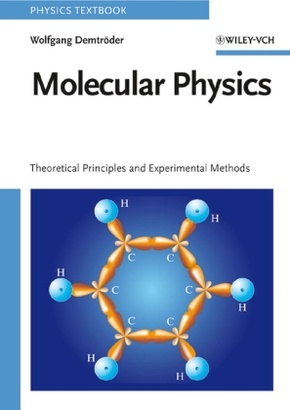
Molecular Physics - Theoretical Principles and Experimental Methods
| Verlag | Wiley-VCH |
| Auflage | 2005 |
| Seiten | 470 |
| Format | 17,1 x 24,1 x 2,4 cm |
| Gewicht | 930 g |
| Artikeltyp | Englisches Buch |
| ISBN-10 | 3527405666 |
| EAN | 9783527405664 |
| Bestell-Nr | 52740566A |
Dieses fortgeschrittene Lehrbuch der Molekülphysik wendet sich an Studenten und Doktoranden aus der Chemie und der Physik; der Autor setzt Grundkenntnisse der Atomphysik und Quantenmechanik voraus. Erklärt werden die Eigenschaften (und, daraus abgeleitet, die Spektren) zwei- und mehratomiger Moleküle - im ersten Teil des Textes vorwiegend theoretisch, im zweiten Teil anwendungsspezifisch unter Berücksichtigung der in der Physik, Chemie, Biologie und Materialwissenschaft eingesetzten Verfahren, insbesondere der Laser-, Fourier-, NMR- und ESR-Spektroskopie.
Rezension:
"Eine genaue Übersicht zur Prüfungsvorbereitung und ein Nachschlagewerk, für alle, die sich im Elementarteilchenzoo besser zurechtfinden wollen."
ORF - Die Physikalische Soiree
"Empfehlen kann man das Buch Studierenden, die ein Lehrbuch über Molekülspektroskopie suchen. Die Stoffaufteilung orientiert sich eher am Bedarf jüngerer Studierender, des ungeachtet ist das Buch ob seiner Ausführlichkeit auch für weiter fortgeschrittene Leser ein Gewinn."
Angewandte Chemie
The richly illustrated book comprehensively explains the important principles of diatomic and polyatomic molecules and their spectra in two separate, distinct parts. The first part concentrates on the theoretical aspects of molecular physics, such as the vibration, rotation, electronic states, potential curves, and spectra of molecules. The different methods of approximation for the calculation of electronic wave functions and their energy are also covered. The introduction of basics terms used in group theory and their meaning in molecular physics enables an elegant description of polyatomic molecules and their symmetries. Molecular spectra and the dynamic processes involved in their excited states are given its own chapter. The theoretical part then concludes with a discussion of the field of Van der Waals molecules and clusters.
The second part is devoted entirely to experimental techniques, such as laser, Fourier, NMR, and ESR spectroscopies, used in the fields of physics, chemistry, biology, and material science. Time-resolved measurements and the influence of chemical reactions by coherent controls are also treated. A list of general textbooks and specialized literature is provided for further reading.
With specific examples, definitions, and notes integrated within the text to aid understanding, this is suitable for undergraduates and graduates in physics and chemistry with a knowledge of atomic physics and familiar with the basics of quantum mechanics.
Inhaltsverzeichnis:
1. Introduction
2. Electronic States of Molecules
3. Rotation, Oscillation and Potential Curves of Diatomic Molecules
4. The Spectra of Diatomic Molecules
5. Molecule Symmetries and Group Theory
6. Rotation and Oscillations of Polyatomic Molecules
7. Electronic States of Polyatomic Molecules
8. The Spectra of Polyatomic Molecules
9. Collapse of the Born-Oppenheimer-Approximation, Disturbances in Molecular Spectra
10. Molecules in Disturbing Fields
11. Van-der-Waals-Molecules and Cluster
12. Experimental Techniques in Molecular Physics
